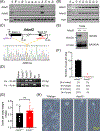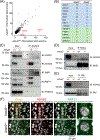ADAD2 functions in spermiogenesis and piRNA biogenesis in mice
- PMID: 36698249
- PMCID: PMC10073342
- DOI: 10.1111/andr.13400
ADAD2 functions in spermiogenesis and piRNA biogenesis in mice
Abstract
Background: Adenosine deaminase domain containing 2 (ADAD2) is a testis-specific protein composed of a double-stranded RNA binding domain and a non-catalytic adenosine deaminase domain. A recent study showed that ADAD2 is indispensable for the male reproduction in mice. However, the detailed functions of ADAD2 remain elusive.
Objectives: This study aimed to investigate the cause of male sterility in Adad2 mutant mice and to understand the molecular functions of ADAD2.
Materials and methods: Adad2 homozygous mutant mouse lines, Adad2-/- and Adad2Δ/Δ , were generated by CRISPR/Cas9. Western blotting and immunohistochemistry were used to reveal the expression and subcellular localization of ADAD2. Co-immunoprecipitation tandem mass spectrometry was employed to determine the ADAD2-interacting proteins in mouse testes. RNA-sequencing analyses were carried out to analyze the transcriptome and PIWI-interacting RNA (piRNA) populations in wildtype and Adad2 mutant testes.
Results: Adad2-/- and Adad2Δ/Δ mice exhibit male-specific sterility because of abnormal spermiogenesis. ADAD2 interacts with multiple RNA-binding proteins involved in piRNA biogenesis, including MILI, MIWI, RNF17, and YTHDC2. ADAD2 co-localizes and forms novel granules with RNF17 in spermatocytes. Ablation of ADAD2 impairs the formation of RNF17 granules, decreases the number of cluster-derived pachytene piRNAs, and increases expression of ping-pong-derived piRNAs.
Discussion and conclusion: In collaboration with RNF17 and other RNA-binding proteins in spermatocytes, ADAD2 directly or indirectly functions in piRNA biogenesis.
Keywords: ADAD1; ADAD2; CRISPR/Cas9; RNA-binding proteins; infertility; male reproduction; piRNA biogenesis; sperm; spermatogenesis; testis.
© 2023 The Authors. Andrology published by Wiley Periodicals LLC on behalf of American Society of Andrology and European Academy of Andrology.
Figures





Similar articles
-
Two RNA binding proteins, ADAD2 and RNF17, interact to form a heterogeneous population of novel meiotic germ cell granules with developmentally dependent organelle association.PLoS Genet. 2023 Jul 10;19(7):e1010519. doi: 10.1371/journal.pgen.1010519. eCollection 2023 Jul. PLoS Genet. 2023. PMID: 37428816 Free PMC article.
-
The functions and mechanisms of piRNAs in mediating mammalian spermatogenesis and their applications in reproductive medicine.Cell Mol Life Sci. 2024 Sep 2;81(1):379. doi: 10.1007/s00018-024-05399-6. Cell Mol Life Sci. 2024. PMID: 39222270 Free PMC article. Review.
-
ADAD2 interacts with RNF17 in P-bodies to repress the Ping-pong cycle in pachytene piRNA biogenesis.J Cell Biol. 2023 May 1;222(5):e202206067. doi: 10.1083/jcb.202206067. Epub 2023 Mar 17. J Cell Biol. 2023. PMID: 36930220 Free PMC article.
-
ADAD1 and ADAD2, testis-specific adenosine deaminase domain-containing proteins, are required for male fertility.Sci Rep. 2020 Jul 14;10(1):11536. doi: 10.1038/s41598-020-67834-5. Sci Rep. 2020. PMID: 32665638 Free PMC article.
-
[Biogenesis and functions of piRNAs in the reproductive system of male mice].Zhonghua Nan Ke Xue. 2016 Aug 20;22(8):746-750. Zhonghua Nan Ke Xue. 2016. PMID: 29020737 Review. Chinese.
Cited by
-
Insights into the role of hnRNPK in spermatogenesis via the piRNA pathway.Sci Rep. 2025 Feb 22;15(1):6438. doi: 10.1038/s41598-025-91081-1. Sci Rep. 2025. PMID: 39987352 Free PMC article.
-
Two RNA binding proteins, ADAD2 and RNF17, interact to form a heterogeneous population of novel meiotic germ cell granules with developmentally dependent organelle association.PLoS Genet. 2023 Jul 10;19(7):e1010519. doi: 10.1371/journal.pgen.1010519. eCollection 2023 Jul. PLoS Genet. 2023. PMID: 37428816 Free PMC article.
-
FBXO24 deletion causes abnormal accumulation of membraneless electron-dense granules in sperm flagella and male infertility.bioRxiv [Preprint]. 2024 Apr 27:2023.11.10.566635. doi: 10.1101/2023.11.10.566635. bioRxiv. 2024. Update in: Elife. 2024 Aug 20;13:RP92794. doi: 10.7554/eLife.92794. PMID: 37986737 Free PMC article. Updated. Preprint.
-
Global knowledge mapping and emerging research trends in non-coding RNAs related to animal and plant male sterility: A visual analysis of CiteSpace maps.Medicine (Baltimore). 2025 Jun 6;104(23):e42612. doi: 10.1097/MD.0000000000042612. Medicine (Baltimore). 2025. PMID: 40489841 Free PMC article. Review.
-
The functions and mechanisms of piRNAs in mediating mammalian spermatogenesis and their applications in reproductive medicine.Cell Mol Life Sci. 2024 Sep 2;81(1):379. doi: 10.1007/s00018-024-05399-6. Cell Mol Life Sci. 2024. PMID: 39222270 Free PMC article. Review.
References
-
- Nishimura H, L’Hernault SW. Spermatogenesis. Curr Biol. 2017;27(18):R988–R994. - PubMed
-
- Pillai RS, Chuma S. piRNAs and their involvement in male germline development in mice. Development, Growth & Differentiation. 2012;54(1):78–92. - PubMed
-
- Aravin A, Gaidatzis D, Pfeffer S, et al. A novel class of small RNAs bind to MILI protein in mouse testes. Nature. 2006;442(7099):203–207. - PubMed
Publication types
MeSH terms
Substances
Grants and funding
LinkOut - more resources
Full Text Sources
Molecular Biology Databases
Research Materials

